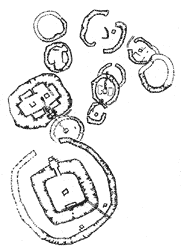
 |  |
| Home |
| About Orkney |
| History |
| Tradition |
| Folklore |
| Placenames |
| Images |
| Downloads |
| About the Site |
| Contact |
| Links |
| Search Site |
| Awards |
| The Barnhouse Neolithic Settlement | |
|
By the south shore of the Harray loch, on a point of land called Antaness, around 150 metres to the north of the Standing Stones o' Stenness, are the remains of an Orcadian Stone Age settlement. Now known simply as the Barnhouse Settlement, only the reconstructed lower courses of a small section of the village's stonework are visible today. But although these meagre remains are nowhere near as impressive as its contemporary, Skara Brae, the Barnhouse Settlement is particularly interesting for a number of other reasons. Barnhouse revealed The village was discovered in the winter of 1984, after a field-walking exercise undertaken by archaeologist, Colin Richards. Agricultural activity over the centuries meant that little remained of the site, but the resulting excavations uncovered evidence of 15 small dwellings in varying stages of development. The structures were round - perhaps with timber and turf roofs - with turf cladding surrounding the outer walls. Because there were no roofed passageways between the huts - such as those at Skara Brae - it appears that the Barnhouse dwellings were free standing and not encased in midden. But particularly intriguing was the fact that each building appeared to have been deliberately demolished at the end of its life. Today, although only the reconstructed lower walls are visible, the similarities between Barnhouse and Skara Brae are obvious. This is not particularly surprising given the two villages were in use at the same time. On closer examination, however, it becomes clear that the Barnhouse structures actually differ in style to Skara Brae. This difference, however, is not great and probably due to the fact that the Barnhouse settlement fell out of use 450 years before Skara Brae. As such, its architecture did not develop to the same extent. Indeed, excavation at Skara Brae has shown that its earliest dwellings were relatively similar to the Barnhouse structures. Elaborate structures
But despite the architectural differences, the Barnhouse Settlement visitor will still be able to pick out the similarities between the two ancient settlements - both have the same central, kerbed hearths, recessed box-beds and stone furniture. But two of the Barnhouse buildings are very different. These structures - House Two and Structure Eight - are larger and more elaborate than the other buildings at Barnhouse or Skara Brae. These differences, clearly apparent on the site plan to the right, prompted the theory that the structures were built to house someone of importance within a tribal hierarchy. We know the Barnhouse settlement was in use at the same time as the Standing Stones o' Stenness and within the largest structure is a central hearth, similar to the one in the Stenness henge. Was the settlement created to house certain individuals who were instrumental in the construction of the stone ring? This might explain why the buildings were demolished after use - when the project was completed the artisans moved on. Home of a priesthood? Another idea is that the village was constructed to house an elite class of "priest". This theory originally surfaced a number of years before Barnhouse was discovered, when it was suggested that Skara Brae was the home of "priests" who officiated at tribal ceremonies in and around the Stenness rings. At the time, however, the idea was abandoned, only to be resurrected after the Barnhouse settlement was found. The design of House Two seems to fit with this idea as there are structural similarities between it and Orkney's chambered cairns. Perhaps this building was not a mere dwelling but was actually some form of meeting hall, connected with the ceremonies at the nearby stone rings. Or were the tribal wise-men cloistered in this sacred compound, close to their ceremonial centre? The ritualistic elements apparent in the design of the Barnhouse settlement and its location in the ceremonial heartland of Neolithic Orkney - the Ring o' Brodgar, the Stenness Stones and Maeshowe are all clearly visible from Barnhouse - certainly lends weight to this idea. A clear connection between Barnhouse and the Standing Stones o' Stenness is the large stone hearth found in the centre of the stone circle. This hearth was constructed from four large stone slabs, and, according to Colin Richards, was transplanted Barnhouse to the interior of the ring. |
The first building at Barnhouse took place around 3300BC. The settlement remained in use for around 700 years, before falling out of use around 2600BC. The settlement takes its name from the nearby farm Barnhouse, on whose land it was found. The actual name of the area in which the village stands is Antaness. At the centre of the settlement was an open area in which the villages made their pottery and worked flint, bone and animal hides. The quantity of material found in the Barnhouse Settlement that was not from Orkney proves that the community was by no means isolated. Instead, the Neolithic Orcadians had contact with other communities down the west coast of Scotland. The interior of the Barnhouse dwellings were more of less identical to the houses of Skara Brae, with the central hearth, recessed beds and stone dressers. The close proximity of the Maeshowe, and the fact that it was constructed while the settlement was thriving, could mean that the inhabitants of the village buried their dead in Orkney's grandest chambered tomb. |

